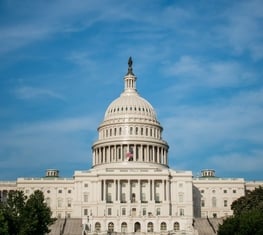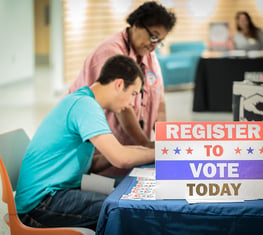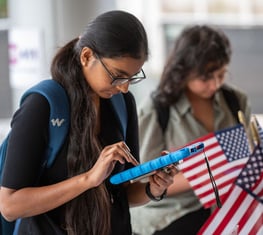Electoral College
This block reviews the racist origins of the Electoral College and why it still hurts Black Americans and other communities of color to this day.
As we confront the challenges posed by the Electoral College and its implications for fair representation, the National Popular Vote Interstate Compact stands as a beacon of hope for a more democratic electoral system, one that aligns with the core principles of equality and voter empowerment.
When you vote for the President of the United States, you are not voting directly for a candidate. Instead, your vote — and the votes of everyone else in your state — directs the votes of the people who vote directly for President: presidential electors, otherwise known as members of the Electoral College.
This blog, and those that will follow, will explain how the Electoral College works, the history of the Electoral College — including its racist origins — and why it must be abolished.
Congress attached legislation to update how votes are counted and cast by the Electoral College to the omnibus appropriations bill that passed in the final days of the 117th Congress.
Current bipartisan proposals would clarify existing ambiguities in the legislation around the role of the Vice President and the certification of electors and offer transparency around how electors are appointed.
LWV believes that the Electoral College is an out-of-date and racist process for electing the president that does not reflect the will of the people.
We're building a One Person One Vote coalition to abolish the Electoral College and ensure American voters choose future presidents through a legitimate, people-powered process: the direct popular vote.
When redistricting is done fairly, each person’s vote is equal to every other person’s because their districts are drawn in ways that accurately represent the voting power of the people within them.
When redistricting is done unfairly, however, and maps are created to favor one party (partisan gerrymandering) or with race as the predominant factor (racial gerrymandering), voters in certain districts are given more power than others.
The League joined a letter written by the Leadership Conference on Civil and Human Rights with 60 other organizations to urge the Senate to reform the outdated Electoral Count Act of 1887 before the end of the year. The Electoral Count Reform and Presidential Transition Improvement Act, S.4573, represents a significant advance forward to securing and protecting our democracy from future attacks on presidential elections.
The Electoral College is often not a well-understood entity. I want to highlight some of the history and shortcomings of this process and offer some possible solutions to replacing this flawed system for the good of the nation and the health of our democracy.
Virginia Kase shares three things about the Electoral College.
The Electoral College has been a part of our democratic process since the start, but what does it really do and what can we expect this year? Here is what you should know.




